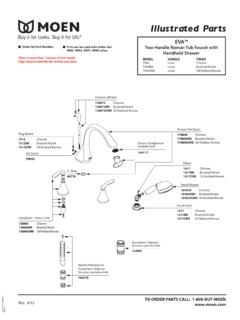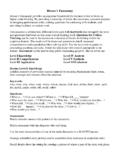Transcription of British hallmarks on silver - The Silver Society
1 British hallmarks on Silver The history of hallmarking in Britain began in the year 1300 in the reign of King Edward the first. It is thus lengthy, and also surprisingly complicated. This short introduction cannot cover all the intricacies; it is intended to be a simple introduction for those with little or no knowledge of the history and practices of hallmarking but are curious about the significance of marks on a piece of Silver . Such items will usually be from the nineteenth or early twentieth century, or possibly the eighteenth century, so the emphasis is on helping to identify hallmarks from these periods, including marks that are not hallmarks , and giving some pointers for further research. The word hallmark is used in its generally accepted sense as a set of marks required by law. To r e c e i v e a h a l l m a r k a n i t e m m u s t b e m a d e o f s i l v e r o f a s p e c i f i e d f i n e n e s s , a n d m u s t p a s s a t e s t a t a n assay office to prove this before it is marked.
2 There are some exceptions to this rule, generally items too small or delicate to bear the hallmarks , such as items of jewellery, although if they are described as Silver they must be of legal fineness. British hallmarks on Silver from the period considered usually comprise four or five individual marks. 1. The standard mark This mark shows that the fineness of the metal meets a specified legal standard. Pure Silver is too soft for objects subject to daily wear so it is alloyed with a base metal, usually copper, to make it more durable This dilutes the precious metal and makes the mixture less valuable. Because the proportion of base metal present cannot be readily assessed, the amount allowed to be added is controlled by law. From ancient times coins and Silver wares were made from sterling Silver , which contains not less than eleven ounces and two pennyweights of pure Silver in the pound troy, that is at least 925 parts of pure Silver in a thousand parts of the metal.
3 Hallmarking was introduced to show that the fineness had been tested and that the base metal content was not more than allowed by law. The leopard's head The standard mark decreed in 1300 was the head of a leopard, but which actually looked somewhat like the mark shown here. The head is actually that of a lion, but the mark was called the leopard's head due to a mistranslation of the Norman-French Act, and it has been called the leopard's head ever since. At first, the leopard's head was uncrowned, but in 1478, the law was made stricter and a crown was added to distinguish items marked under the new tighter rules. Over time, the mane and beard were removed, and the mark was gradually made to look more like a leopard. The leopard's head was first marked by the London Assay Office at Goldsmiths' Hall, and some books on hallmarking say that it is the town mark of the London Assay Office and shows that items were hallmarked there.
4 However, after 1720, it was also marked by some provincial assay offices in England (see the section Town mark below). The leopard's head marked by the London Assay Office on sterling Silver remained crowned until 1821, after that it was uncrowned. The mark here is a leopard's head struck by the London Assay Office in 1886/87, and you can see that it looks more like a leopard than the earlier mark. As is often the case, this mark is rubbed from polishing, and the original fine detail lost; only the eyes and the outline of the head with ears and whiskers can be distinguished. The lion passant During the reign of King Henry VIII, an additional standard mark was introduced in 1544 - the "lion passant". This is a lion walking across the field of view, with three paws on the ground and right forepaw raised. The lion passant marked by the London Assay Office was initially also guardant , his head turned over his shoulder to face the viewer, but after 1821 he faced in the direction he was walking.
5 The lion passant was also marked by provincial assay offices in England after 1720; sometimes passant, sometimes passant guardant. The difference is shown in tables of marks and can be useful in dating an item. The lion passant became the most widely recognised hallmark symbol because, after 1720, it was used by all of the English assay offices. Although the other marks all varied from place to place depending on which assay office was used, the same lion passant was always present on English sterling Silver . Other assay office standard marks The standard mark for sterling Silver used by the Edinburgh Assay Office was a Scottish thistle, the Glasgow office a lion rampant, and Dublin a harp crowned. Until the Britannia standard (see below) was introduced, English provincial assay offices used their own marks, which can be found in reference books if you are lucky enough to find a piece of Silver from before 1697.
6 Britannia Silver Until the end of the seventeenth century, Silver coins and Silver wares were all required to be made from sterling Silver . In 1697, a higher standard for Silver wares was introduced to stop them being made from melted coins. This new standard was not less than eleven ounces and ten pennyweights of pure Silver in the pound troy; that is, at least parts pure Silver in 1000. To indicate the new higher standard, the mark of the leopard's head was replaced by a lion's head erased , meaning with a jagged neckline, and the lion passant was replace by a figure of Britannia seated. This new , or Britannia standard was the only legal standard for Silver wares until 1720 when sterling was also allowed again, and the two standards remain legal to this day. 2. Town mark If an item of Silver was hallmarked outside London, the town mark identifies at which office it was marked. The best known of these are:- Chester a sword between three wheatsheaves, Birmingham a ship's anchor, Sheffield a crown, Edinburgh a three towered castle, Glasgow a tree with a fish, a bird and a bell, and Dublin a seated figure of Hibernia.
7 There were other provincial assay offices in earlier times that had their own distinguishing marks. NB: the assay office where an item was hallmarked may not be where it was actually made. The London Assay Office was the only office that didn't have its own town mark. Until the Britannia standard was introduced, London was the only office that marked the leopard's head and lion passant on Silver . However, the assay offices of Chester, Exeter, Newcastle upon Ty n e a n d Yo r k w e r e a u t h o r i s e d t o s t r i k e t h e n e w m a r k s o f t h e l i o n s h e a d e r a s e d a n d t h e figure of Britannia on Silver of the new standard. When the old standard was reintroduced in 1720, these offices were also authorised to strike the leopard's head and lion passant on sterling Silver . The mark of a leopard's head and lion passant without an additional town mark shows that the item was hallmarked in London, but the leopard's head and lion passant marks can also be found on Silver marked at provincial English assay offices, when they are accompanied by a town mark that shows which office.
8 The set of marks shown here were struck at Newcastle in 1860 or 1861. The leopard's head is visible below the town mark of three castles of the Newcastle Assay Office. Along with the lion passant, the leopard's head was struck by the assay offices of Chester with a crown until 1809 and then without until 1839, Exeter with a crown until 1778, York with a crown until the 1850s and Newcastle with a crown until it closed in 1884. After those dates, these offices struck only the lion passant as the standard mark. The reason why the provincial offices stopped striking the leopard's head standard mark alongside the lion passant is not known. The Birmingham and Sheffield Assay Offices, authorised in 1773, never struck the leopard's head mark. 3. Date letter The date letter was originally introduced in 1478 to show who had been the assayer when a piece was tested and hallmarked. It was changed each year when new wardens were elected, which was part way through the calendar year, and so it can be used to determine the period spanning two calendar years in which the piece was marked.
9 The example shown here is the London date letter for 1819 to 1820. It is important to note that each assay office had its own unique sequences of date letters, and that the assay offices changed their date letters on different dates. In reading a date letter, both the shape or font of the letter and the shape of the enclosing shield are important. The assay offices changed the fonts and shields for each cycle of date letters so that they were unique, although some letters can still be problematic and other marks or features have to be considered to help reach a conclusion. 4. Sponsor's mark Before sending items for hallmarking, a person had to enter their details and a unique punch mark at the assay office. The registered punch mark was impressed onto items before they were sent for assay. The mark originally indicated the master goldsmith in whose workshop the piece was made (Rebecca Emes and Edward Barnard in this example) and became known as the maker s mark although it was never intended for the purpose of identifying who actually made the item.
10 The well known eighteenth century silversmith Paul de Lamerie subcontracted work to other workshops, although striking the finished wares with his own punch, and as trade and manufacturing became more complex, it was recognised that the person who sent an item to be hallmarked might not have been involved in its manufacture but might instead be a retailer or importer. The person submitting an item took responsibility, one of the meanings of the term sponsor, for the fineness of the metal, and bore the penalty if it was found to be substandard, so today the term sponsor s mark is used for this mark. 5. Duty mark In 1784, duty was made payable on Silver . This was collected by the assay offices, and a mark of the sovereign's head stamped to show that it had been paid. Watch cases were made exempt from duty in 1798 and the duty marks shown in tables of hallmarks are not found in watch cases after that date.






